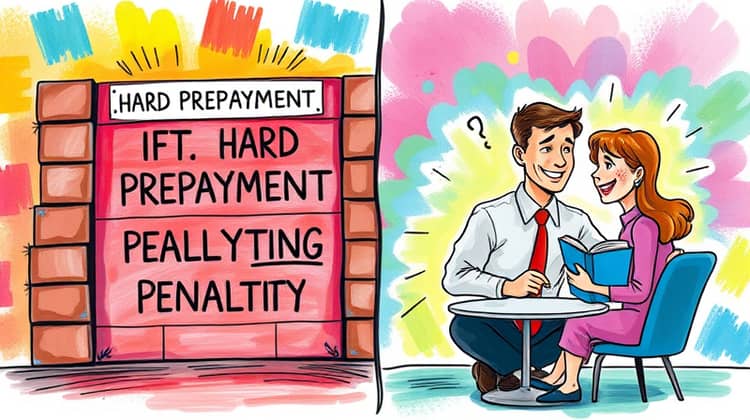Prepayment penalties often spark heated debates among borrowers, lenders, and financial advisors. This financial term refers to the fees incurred when one pays off a loan, generally a mortgage, before the agreed-upon term ends. Many borrowers may be unaware of these penalties until they’re staring at a hefty fee after paying off their loan early. Understanding prepayment penalties allows borrowers to anticipate potential costs and make informed financial decisions.
For the financially literate, prepayment penalties can represent a significant issue, especially in a fluctuating interest rate environment. Borrowers often refinance their loans when interest rates drop to save money, but a prepayment penalty can turn a seemingly beneficial decision into an expensive one. Thus, knowing how these penalties work can save borrowers from making costly mistakes as they manage their debt effectively.
This article will delve into the intricacies of prepayment penalties. We will define what they are, explore their purpose, examine the different types, and discuss both the pros and cons associated with them. Lastly, we'll provide strategies to avoid these penalties when taking out loans.
Definition of Prepayment Penalty

A prepayment penalty is a fee charged to borrowers who pay off a loan before its maturity date. These fees are designed to compensate lenders for the lost interest income that results from an early repayment. In essence, when a borrower pays off a loan early, the lender loses out on the expected interest payments that they would have accrued over the life of the loan. Consequently, lenders may impose a penalty to mitigate this loss.
Typically, prepayment penalties are outlined in the loan agreement, and borrowers are encouraged to read the fine print carefully. The structure of these penalties can vary greatly from one lender to another. Some loans might have a fixed fee, while others might have a percentage of the remaining balance as a penalty. Understanding these differences is crucial for any borrower considering a loan that includes a prepayment penalty.
Prepayment penalties are more common in certain types of loans, particularly subprime mortgages or loans designed for borrowers with lower credit scores. Home buyers should carefully consider whether the savings from lower monthly payments outweigh the risks of incurring this type of penalty when making their decisions.
Why Prepayment Penalties Exist

Prepayment penalties exist primarily to protect lenders’ investment. When lenders provide loans, they base their financial models on expected interest payments spread over a specific period. If borrowers prepay loans early, lenders are left with unanticipated losses, which could impact their financial stability.
Additionally, prepayment penalties serve to discourage borrowers from refinancing their loans whenever interest rates drop. This situation ensures that lenders can rely on the loan’s interest income for the period agreed upon in the contract, which provides them greater predictability in their revenue stream.
- Protect lenders’ investment by ensuring continued interest income.
- Prevent borrowers from refinancing frequently, which can disrupt lenders' income flow.
- Help lenders offset potential market high-risk losses.
Types of Prepayment Penalties

Understanding the types of prepayment penalties is key for borrowers looking for loans. While the exact details can vary by lender and loan type, there are generally two main categories: hard and soft prepayment penalties. Each type has unique features and implications that borrowers should be aware of before signing any loan agreements.
Knowing the differences between these penalties can enhance a borrower’s negotiating position. By discussing the terms clearly with lenders upfront, borrowers can protect themselves from unexpected charges later.
1. Hard Prepayment Penalty
A hard prepayment penalty is a strict form of penalty that applies whenever a borrower pays off their loan early, regardless of the circumstances. This type of penalty can significantly impact the financial decisions of borrowers, as it adds a layer of cost to an early repayment that could be quite substantial.
- Typically a fixed percentage of the remaining loan balance.
- Applies in all situations, including refinancing or selling the property.
- Can often last for the entirety of the loan term.
2. Soft Prepayment Penalty
In contrast, a soft prepayment penalty is less severe and usually only applies under certain circumstances. For instance, borrowers may be able to avoid penalty fees if they sell their house or refinance under specific conditions. This flexibility makes soft prepayment penalties a more borrower-friendly option.
Those considering loans should carefully examine these terms, as they can provide opportunities for savings if the borrower’s financial situation changes.
- Generally applies only if the borrower refinances the loan.
- May not apply if the property is sold.
- Often has a shorter time period than hard penalties.
How Prepayment Penalties Work

Prepayment penalties are usually calculated based on the outstanding balance of the loan and the terms specified in the loan agreement. For example, if a borrower has an outstanding loan balance of $200,000 and the penalty is set at 2%, they could face a fee of $4,000 upon early repayment.
These penalties typically last for a predetermined period, which can range from a few months to several years, depending on the loan type and lender. Borrowers should be aware of this timeline as it can influence their decision to refinance or pay off a loan early.
For many borrowers, understanding how prepayment penalties are triggered is also essential. Some penalties might gradually decrease over time, while others might remain fixed for the duration of the loan. Being informed about these details can make a significant difference in how borrowers manage their loans.
Pros and Cons of Prepayment Penalties

While prepayment penalties can serve as a protective measure for lenders, they also come with certain downsides for borrowers. On the one hand, loans with prepayment penalties might come with lower interest rates, which could lead to savings over time if borrowers do not pay off the loan early. Additionally, these loans might be easier to qualify for, helping borrowers secure financing they might not otherwise obtain.
On the other hand, prepayment penalties may restrict borrowers' financial flexibility, leading to unexpected costs during refinancing or early repayment. Therefore, borrowers must weigh these advantages and disadvantages when considering loans that include prepayment penalties.
- Can lead to lower interest rates for borrowers.
- Might assist borrowers in obtaining loans that fit their needs.
- May create future financial constraints and unexpected costs.
Avoiding Prepayment Penalties

Borrowers looking to avoid prepayment penalties should thoroughly review the terms of any loan agreement before signing. One option is to negotiate with lenders for loans that do not include prepayment penalties or seek loans that primarily feature soft penalties instead of hard penalties.
Additionally, becoming familiar with lender-specific policies regarding prepayment penalties can allow borrowers to make educated choices and identify flexible loan options that might better suit their long-term financial goals.
- Negotiate with lenders for better loan terms.
- Opt for loans with soft prepayment penalties.
- Stay informed about flexible loan options and policies.
Ultimately, preventing penalization requires careful planning and due diligence on the part of the borrower. By understanding the impact of prepayment penalties and assessing different options, borrowers can better navigate the lending landscape. This approach ensures they make the best financial decisions for their individual circumstances.
Consulting with a financial advisor can also provide insights into the nuances of prepayment penalties and help illustrate how these terms can affect overall financial health. Financial literacy is a critical tool for protecting against unnecessary fees and charges.
Finally, always maintain open communication with lenders, asking questions to clarify unclear aspects of loan agreements. This practice not only promotes transparency but also equips borrowers with the knowledge needed to secure favorable loan terms that align with their goals.














